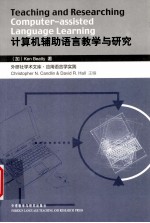

计算机辅助语言教学与研究PDF电子书下载
- 电子书积分:11 积分如何计算积分?
- 作 者:(加)KEN BEATTY著
- 出 版 社:北京:外语教学与研究出版社
- 出版年份:2012
- ISBN:7560085296
- 页数:259 页
Introduction 1
Section Ⅰ Key concepts 5
1 The emergence of CALL 7
1.1 The emergence of CALL 7
1.2 Technology driving CALL 11
1.3 The changing focus of research in CALL 13
Summary 15
2 A brief history of CALL 16
2.1 CALL in the 1950s and 1960s 16
2.2 Simulations 19
2.3 CALL in the 1970s and 1980s 23
2.4 CALLin the 1990s 34
Summary 36
3 Hypertext,hypermedia and multimedia 37
3.1 Hypertext 37
3.2 Hypermedia 38
3.3 Multimedia 39
3.4 Antecedents of multimedia 41
3.5 Science fiction and CALL 42
3.6 The printed book and CALL 45
3.7 Applications to general learning 48
3.8 Applications of multimedia to language learning 49
Summary 50
4 Eight CALL applications 52
4.1 Word processing 52
4.2 Games 54
4.3 Literature 57
4.4 Corpus linguistics 59
4.5 Computer-mediated communication 62
4.6 WWW resources 68
4.7 Adapting other materials for CALL 70
4.8 Personal Digital Assistants(PDA) 72
Summary 74
Section Ⅱ The place of CALL in research and teaching 75
5 Second-language Acquisition and models of instruction 77
5.1 Concepts in SLA,behaviourism and constructivism 77
5.2 Comprehensible input and output 81
5.3 Criticism of comprehensible input and output theory 83
5.4 Behaviourist and constructivist models of instruction 84
5.5 Behaviourism 85
5.6 Constructivism 91
5.7 The role of collaboration and negotiation of meaning in the two models 97
Summary 98
6 Collaboration and negotiation of meaning 99
6.1 The place of collaboration in CALL 99
6.2 Structuring collaboration 106
6.3 Differences between collaboration and other terms 109
6.4 The range of collaboration and CALL 110
6.5 Collaboration at the computer 111
6.6 Benefits of collaborative learning at the computer 112
6.7 Collaboration,CALL and SLA 114
6.8 Collaboration at the computer as evidenced by discourse 116
6.9 Challenges to collaboration 121
6.10 Challenges to collaboration in a CALL context 122
6.11 Discourse that evidences challenges to collaboration 125
Summary 130
7 Defining a model of CALL 132
7.1 Defining model 132
7.2 The need for a CALL model 133
7.3 A model of current non-CALL language learning 134
7.4 Dunkin and Biddle's model in a CALL context 136
7.5 Various views of CALL 140
7.6 Teacher and pupil classroom behaviour:activities used in CALL 143
7.7 A virtual classroom 145
7.8 Aspects of a CALL model 146
Summary 147
8 Theoretical and pedagogical concerns 148
8.1 Concerns for software development 148
8.2 Pedagogical concerns for classroom practice 151
8.3 Evaluating software 155
8.4 Learning and working styles 155
8.5 Evolving technology 156
8.6 Commercial software 159
8.7 Making better use of existing materials 161
8.8 Copyright and plagiarism 164
8.9 Viruses 165
8.10 Safety online 168
8.11 Technological have-nots 170
Summary 171
Section Ⅲ Researching CALL 173
9 Current research interests 175
9.1 A new field:reporting CALL research 175
9.2 Approaches to research in CALL 177
9.3 The computer as a tool of research 178
9.4 The role of commercial publishers 178
9.5 Reviewing current studies:a survey 179
9.6 Conducting research 190
9.7 Action research 191
Summary 193
10 Research 195
10.1 Research context 1:The literature review 197
10.2 Research context 2:A pilot study 199
10.3 Research context 3:Corpus linguistics 202
10.4 Research context 4:Error analysis 203
10.5 Research context 5:The experiment 206
10.6 Research context 6:A case study 208
10.7 Research context 7:The survey 211
10.8 Research context 8:The ethnographic approach 214
Conclusion 216
Section Ⅳ Resources 219
Glossary of key terms 230
References 237
Index 252
- 《计算机网络与通信基础》谢雨飞,田启川编著 2019
- 《大学计算机实验指导及习题解答》曹成志,宋长龙 2019
- 《培智学校义务教育实验教科书教师教学用书 生活适应 二年级 上》人民教育出版社,课程教材研究所,特殊教育课程教材研究中心编著 2019
- 《指向核心素养 北京十一学校名师教学设计 英语 七年级 上 配人教版》周志英总主编 2019
- 《新课标背景下英语教学理论与教学活动研究》应丽君 2018
- 《大学英语教学的跨文化交际视角研究与创新发展》许丽云,刘枫,尚利明著 2020
- 《中国少数民族唢呐教学曲选》胡美玲编 2019
- 《计算机辅助平面设计》吴轶博主编 2019
- 《语文阅读与写作教学研究》李玉红,陈晓玲,王芬著 2018
- 《语文教育教学实践探索》陈德收 2018
- 《中风偏瘫 脑萎缩 痴呆 最新治疗原则与方法》孙作东著 2004
- 《水面舰艇编队作战运筹分析》谭安胜著 2009
- 《王蒙文集 新版 35 评点《红楼梦》 上》王蒙著 2020
- 《TED说话的力量 世界优秀演讲者的口才秘诀》(坦桑)阿卡什·P.卡里亚著 2019
- 《燕堂夜话》蒋忠和著 2019
- 《经久》静水边著 2019
- 《魔法销售台词》(美)埃尔默·惠勒著 2019
- 《微表情密码》(波)卡西亚·韦佐夫斯基,(波)帕特里克·韦佐夫斯基著 2019
- 《看书琐记与作文秘诀》鲁迅著 2019
- 《酒国》莫言著 2019
